新视野大学英语教案第2册
新视野大学英语读写教程2教案
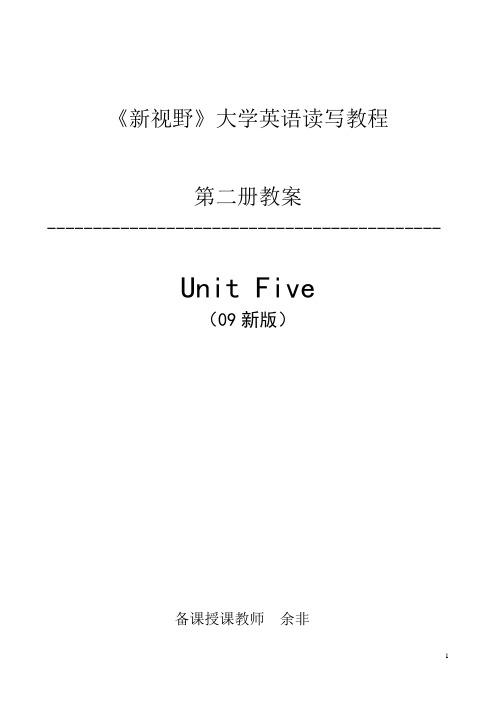
《新视野》大学英语读写教程第二册教案-------------------------------------------Unit Five(09新版)备课授课教师余非新视野《大学英语》读写教程(新版)第二册Unit 5 (Book II)Section A Weeping for My Smoking Daughter 我为女儿抽烟哭泣(精读)Section B Stop Spoiling Your Children 别再宠坏孩子(快读)Section A Weeping for My Smoking Daughter 我为女儿抽烟哭泣(精读)➢硬起心肠不做…harden oneself against …➢穿着黑色燕尾服(be) dressed in a black dress coat➢到40年代末、50年代初by the late forties and early fifties➢加上,外加coupled with➢抽烟上瘾be hooked by cigarettes➢把…争取过来win over➢使某人虚弱不堪leave sb. low➢针对direct at➢连续不断地抽烟drag away➢在(印地安人)居留地on reservations➢久而久之over time➢缺乏starve of➢烟蒂the ends of cigarettes➢怀孕be pregnant➢园艺杂志gardening magazine➢有气无力挣扎着呼吸struggle to breathe feeling half the strength➢受伤害妇女收容所 a battered women’s shelter➢一种自我毁灭 a form of self-battering---------------------------------------------------------------------------------------------------------------------------------------- Text Structure Analysis:The passage is a first person narrative about the writer’s responses toward the problem of her daughter’s smoking. The writer tries to show how smoking is harmful to her own father and to the people in poor countries as examples to support her feelings against her daughter’s smoking. And then she concludes that every home should be a no-smoking zone.The writer organizes paragraphs by using “Cause and Effect” writing skill.The passage is divided into three parts.Part One: (Para.1)--- The paragraph tells us that the writer’s daughter smoke. As a mother she feels severely hurt at her daughter’s smoking.Part Two: (Paras. 2-5)--- The writer recalls how her father was hooked and eventually killed by cigarettes.Part Three: (Paras. 6-8)--- This part shows that the writer gains a better understanding of the harm of smoking in the Third World countries and appeal to all people to stop smoking at families.------------------------------------------------------------------------------------------------------------------------------------ Detailed Study of the Text:( 12 key points)1.Weeping for My Smoking Daughter . (Title)⏹weep for/over: 为…哭泣如:听译--- The girl wept over her sad fate. 女孩为自己的苦命而哭泣。
(完整版)新视野大学英语第二册(第三版)教案

New Horizon CollegeEnglishBOOK 2(3rd Edition)Unit 1 An Impressive English Lesson课型:□ 理论课√ 理论、实践课□ 实践课课时分配: 6教学环境:多媒体教室教学目标:After studying this unit, the students are expected to be able to:1. understand the main idea and structure of Section A and Section B;2. master the key language points and grammatical structures in the texts3。
talk about language teaching and learning and express their opinions about current way of teaching in an English class;4. read with the skill ―finding key ideas in sentences;5. write a composition with three main parts: introduction, body and conclusion. Key Issues:1. VocabularyTedious, absorbed, allergic, capture, condense, exceed, distinguish, distinctive, complimentary, complementary, proclaim, evidently, adequate, competent,adjust, beneficial2。
SkillsLearn to read with the skill ―finding key ideas in sentences and write a composition with three main parts: introduction, body and conclusion.Potential Problems and Difficulties●To talk about language teaching and learning●write a composition with three main parts: introduction, body and conclusion。
大学英语c2的课本教案
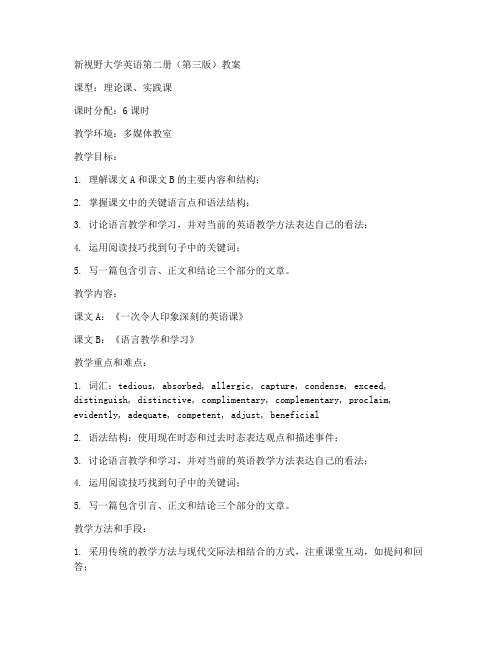
新视野大学英语第二册(第三版)教案课型:理论课、实践课课时分配:6课时教学环境:多媒体教室教学目标:1. 理解课文A和课文B的主要内容和结构;2. 掌握课文中的关键语言点和语法结构;3. 讨论语言教学和学习,并对当前的英语教学方法表达自己的看法;4. 运用阅读技巧找到句子中的关键词;5. 写一篇包含引言、正文和结论三个部分的文章。
教学内容:课文A:《一次令人印象深刻的英语课》课文B:《语言教学和学习》教学重点和难点:1. 词汇:tedious, absorbed, allergic, capture, condense, exceed, distinguish, distinctive, complimentary, complementary, proclaim, evidently, adequate, competent, adjust, beneficial2. 语法结构:使用现在时态和过去时态表达观点和描述事件;3. 讨论语言教学和学习,并对当前的英语教学方法表达自己的看法;4. 运用阅读技巧找到句子中的关键词;5. 写一篇包含引言、正文和结论三个部分的文章。
教学方法和手段:1. 采用传统的教学方法与现代交际法相结合的方式,注重课堂互动,如提问和回答;2. 分组讨论和配对练习,鼓励学生积极参与,提高他们的口语表达能力;3. 提供视觉辅助材料、投影仪、立体声和麦克风等教学工具,帮助学生更好地理解课文和进行讨论;4. 引导学生进行课外学习,提供更多的指导和支持。
教学过程:第一课时:一、导入(5分钟)1. 问候和热身问题讨论:什么是帮助人们学习英语的关键因素?你在英语学习中有没有遇到过问题?你认为语法在英语学习中重要吗?二、听力练习(15分钟)1. 听力练习:听一段关于英语教学和学习的谈话,并回答相关问题。
第二课时:一、课文A:《一次令人印象深刻的英语课》(25分钟)1. 阅读课文A,理解主要内容和结构;2. 讨论课文A中的关键语言点和语法结构;3. 练习使用课文A中的词汇和语法结构进行口语表达。
新视野大学英语第2册教案

一、教学目标1. 知识目标:(1)掌握本单元的核心词汇和短语;(2)了解本单元的篇章结构、写作特点和背景知识;(3)学会运用本单元的语法知识。
2. 能力目标:(1)提高阅读理解能力,学会从不同角度分析文章;(2)提高写作能力,能够运用所学知识写出一篇通顺的短文;(3)提高口语表达能力,能够进行简单的日常对话。
3. 情感目标:(1)激发学生对英语学习的兴趣,培养学生良好的学习习惯;(2)培养学生关注时事、关注社会的意识;(3)培养学生团队协作、相互尊重的精神。
二、教学重点与难点1. 教学重点:(1)核心词汇和短语;(2)篇章结构、写作特点和背景知识;(3)语法知识。
2. 教学难点:(1)阅读理解中的长难句;(2)写作中的篇章结构;(3)口语表达中的连贯性和准确性。
三、教学方法1. 讲授法:教师通过讲解、示范等方式,引导学生掌握本单元的核心知识和技能。
2. 讨论法:教师组织学生进行小组讨论,培养学生的合作意识和沟通能力。
3. 案例分析法:教师选取典型案例,引导学生分析问题,提高学生的实际操作能力。
4. 角色扮演法:教师设计情景,让学生进行角色扮演,提高学生的口语表达能力。
四、教学过程1. 导入新课(1)教师简要介绍本单元的背景知识;(2)引导学生回顾上一单元所学内容,为新课做好铺垫。
2. 阅读理解(1)教师引导学生阅读课文,注意关键词汇和短语;(2)学生分组讨论,分析文章结构、写作特点和背景知识;(3)教师总结讨论结果,讲解课文中的难点。
3. 词汇教学(1)教师讲解本单元的核心词汇和短语;(2)学生通过例句学习词汇用法;(3)进行词汇测试,巩固所学知识。
4. 写作训练(1)教师讲解写作技巧,引导学生进行写作;(2)学生分组讨论,互相修改作文;(3)教师点评学生作文,总结写作要点。
5. 口语表达(1)教师设计情景,让学生进行角色扮演;(2)学生分组练习,提高口语表达能力;(3)教师点评学生的口语表达,纠正错误。
新视野大学英语第二册Unit 2教案
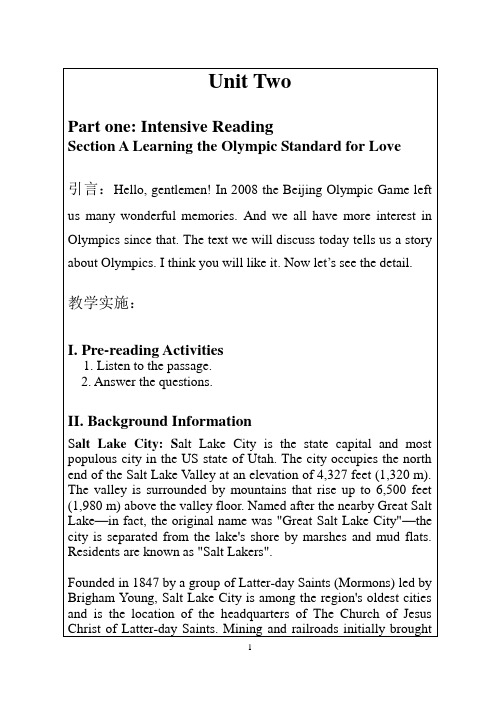
Why are you making so much fuss over losing 10yuan?
你为什么对丢了10元钱如此小题大做呢?
She must be making a fuss about nothing again.
她肯定又是在为一些无谓的事情大惊小怪。
11.bachelorn.
她租了套单身公寓,安顿了下来。
2)[C] a first university degree学士(学位)
a Bachelor of Science
理学士
a Bachelor of Arts
文学士
12.shift
v.change position or direction; move from one place to another转移;移动;变换
1)[C] an unmarried man未婚男子
I don't like the idea of getting married, so I will remain a bachelor all my life.
我不喜欢结婚,所以我会一辈子单身。
She rented a bachelor flat and settled down.
这些业余篮球运动员每周集训两次。
n.[C] sb. who does sth. just for pleasure
业余爱好者
Only amateurs will be allowed to participate in this match.
只有业余爱好者才能参加此项比赛。
Some amateurs can perform at such a high level that even professionals sing high praise for them.
(完整word版)新视野大学英语(第三版)读写教程第二册完整教案.doc
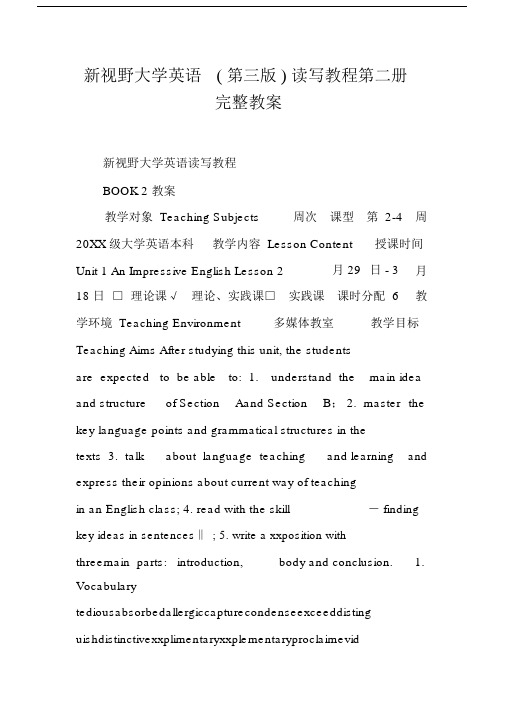
新视野大学英语( 第三版 ) 读写教程第二册完整教案新视野大学英语读写教程BOOK 2 教案教学对象 Teaching Subjects 周次课型第 2-4 周20XX 级大学英语本科教学内容 Lesson Content 授课时间Unit 1 An Impressive English Lesson 2 月 29 日 - 3 月18 日□理论课√ 理论、实践课□ 实践课课时分配 6 教学环境 Teaching Environment 多媒体教室教学目标Teaching Aims After studying this unit, the studentsare expected to be able to: 1. understand the main idea and structure of Section Aand Section B; 2. master the key language points and grammatical structures in thetexts 3. talk about language teaching and learning and express their opinions about current way of teachingin an English class; 4. read with the skill ― finding key ideas in sentences‖ ; 5. write a xxposition withthreemain parts: introduction, body and conclusion. 1. Vocabulary tediousabsorbedallergiccapturecondenseexceeddisting uishdistinctivexxplimentaryxxplementaryproclaimevidentlyadequatexxpetentadjustbeneficial 2. Skills ●Learn to read with the skill ― finding key ideas in sentences ‖and write a xxposition with threemain parts: introduction, body and conclusion. ● To talk about language teaching and learning ● write a xxposition with threemain parts: introduction, bodyand conclusion. ● To apply the phrases and patterns 重点 Key Issues 难点 PotentialProblems and Difficulties教学方法Methodology A xxbination of traditional teaching methods with the xxmunicative approach willbe adopted. Special attention should be paid to classroom interaction like questioning and answers.Small group works are always needed while discussingthe questions and the difficult translation encouragement is needed and more guidance will be given in their extracurricular study. Visual aids, projector, stereo and microphone 教具 Teaching Aids 教学分组Teaching Groups Group work and pair work 课堂学习任务与活动的组织 Conduct of Tasks and Activities Students-centered Task-based teaching and learning教学过程设计Teaching Procedures 步骤 1Step 1 导入Lead-in warming-up questions discussion. 1. What arethe key factors that help people learn English as aforeign language 2. Do you have any problem in Englishlearning you think grammar is important in Englishlearning II. Listening and discussing. 1. Listeningpractice. 2. In your opinion, what is the most effectiveway to learn English III. Listening to a talk and answer questions on page 2 步 2Step 2 文学 Section A An Impressive English Lesson I. New words 1. tedious: a.boring and continuing for too long冗乏味的Tellingthe story has bexxe tedious, as I have done it so manytimes. 述个故事已得乏味,因我已了么多次了。
新视野大学英语2课文教案

课程名称:《新视野大学英语2》教学目标:1. 理解课文内容,掌握课文中的主要观点和论据。
2. 提高学生的阅读理解能力和英语口语表达能力。
3. 培养学生独立思考和批判性思维能力。
4. 增强学生的跨文化交际意识。
教学内容:课文标题:《A New Perspective on Education》教学重点:1. 课文中的主要观点和论据。
2. 关键句型的理解和运用。
3. 课文中的文化背景知识。
教学难点:1. 复杂句型的理解和翻译。
2. 文化差异的理解和应对。
教学准备:1. 课文原文及相关背景资料。
2. 教学PPT或黑板。
3. 学生作业。
教学过程:一、导入1. 教师简要介绍课文标题和作者,激发学生的兴趣。
2. 提问:你对教育有什么看法?你认为教育应该是什么样的?二、课文阅读与理解1. 学生自读课文,标注生词和难点。
2. 教师讲解课文中的生词和难点,如:pedagogy、curriculum、discipline等。
3. 学生分组讨论课文中的主要观点和论据,分享自己的理解。
三、课文分析1. 教师引导学生分析课文结构,如:引言、主体、结论。
2. 分析课文中的关键句型,如:It is widely believed that...;However, this is not the case...3. 讨论课文中的文化背景知识,如:美国的教育制度、教育理念等。
四、课堂活动1. 学生扮演不同角色,进行角色扮演,模拟课文中的场景。
2. 教师组织辩论活动,让学生就教育问题进行正反方辩论。
五、总结与反思1. 教师总结课文的主要观点和论据。
2. 学生分享自己的学习心得,提出自己的疑问。
3. 教师针对学生的疑问进行解答,强调重点和难点。
六、作业布置1. 学生完成课后练习题,巩固所学知识。
2. 写一篇关于教育的短文,表达自己的观点。
教学反思:1. 本节课通过多种教学手段,提高了学生的阅读理解能力和英语口语表达能力。
2. 学生在课堂活动中积极参与,展现了良好的合作精神和批判性思维能力。
新视野第三版第二册读写教案
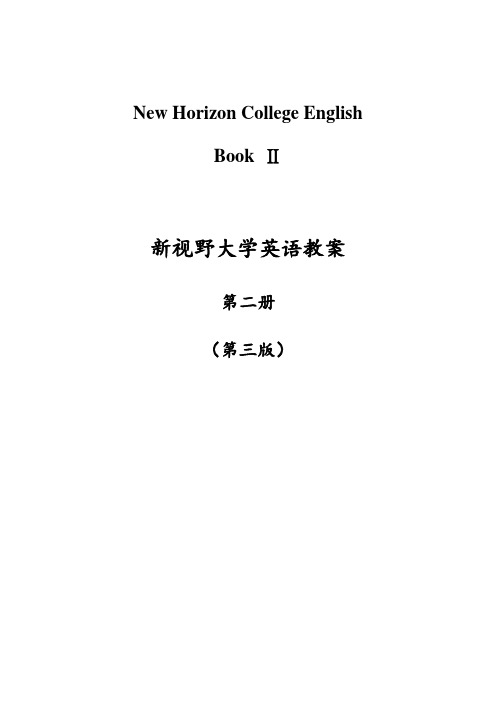
新视野大学英语教案
第二册 (第三版)
课题目(教学章节或主题) :
Unit 1 An Impressive English Lesson
教学目标或要求: Students are supposed to 1. think and talk about language teaching and learning 2. understand and know the main idea of the text 3. learn and apply words, phrases and sentence patterns 4. master the essay writing skill 教学重点、难点: Key points: 1. text understanding 2. language points Difficult points: 1. language use 2. writing skill application 教学进程(包括基本内容、环节、步骤) : 教学时数:6 学时 I. Pre-reading activities and text study (2 学时) II. Text study and essay writing (2 学时) III. Language focus and critical thinking (2 学时) 教学手段与方法: (Application of BOPPPS Model) 思考题、讨论题、作业: Do you think grammar is important in English learning? How can students enlarge their vocabulary? Write an essay using the writing model: introduction-body-conclusion. 教学过程: I. Pre-reading activities and text study 1. Bridge-in Idea-sharing: an unforgettable English lesson 2. Objective Students are required to: 1)think and talk about English teaching and learning 2)understand and know the main idea of the text 3. Pre-test Listen to a talk about an English learner’s learning experience and answer questions. 4. Participatory Learning (1) Pre-reading activities Discuss the following questions. a. In your opinion, what is the most effective way to learn English? b. What do you think is the most difficult in English learning? c. Do you think grammar is important in English learning? (2) Text understanding i. What does the son think of the father? (Para. 1)
新视野大学英语读写教程第2册教案
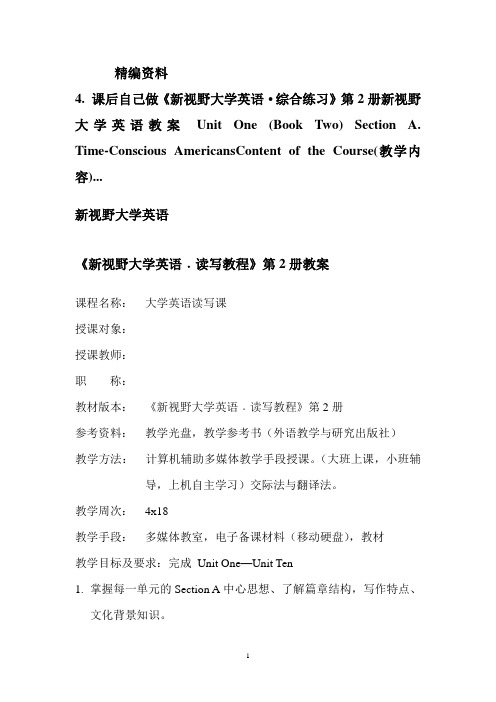
精编资料4. 课后自己做《新视野大学英语·综合练习》第2册新视野大学英语教案Unit One (Book Two) Section A. Time-Conscious AmericansContent of the Course(教学内容)...新视野大学英语《新视野大学英语﹒读写教程》第2册教案课程名称:大学英语读写课授课对象:授课教师:职称:教材版本:《新视野大学英语﹒读写教程》第2册参考资料:教学光盘,教学参考书(外语教学与研究出版社)教学方法:计算机辅助多媒体教学手段授课。
(大班上课,小班辅导,上机自主学习)交际法与翻译法。
教学周次:4x18教学手段:多媒体教室,电子备课材料(移动硬盘),教材教学目标及要求:完成Unit One—Unit Ten1.掌握每一单元的Section A中心思想、了解篇章结构,写作特点、文化背景知识。
2.掌握并背诵每一单元的Section A的核心词汇和短语、核心句型。
并能举一反三,熟练运用。
写出较通顺的短文。
3.自学Section B 和Section C 的内容。
4.课后自己做《新视野大学英语﹒综合练习》第2册新视野大学英语教案Unit One (Book Two)Section A. Time-Conscious Americans(一)C ontent of the Course(教学内容)Section A. Time-Conscious Americans(二)A udience(教学对象)(三)Teaching Span(教学时间)6---7学时(四)Teaching Aims(教学目的)1. Appreciate the text to know something about how American people makeuse of their time.2. Learn to use some important words, expressions and sentence patterns.3. Practice listening, speaking, reading and writing.4. Learn some translation skills(五)Instruction Objectives &. Teaching Procedures(教学任务及步骤)Step One Pre-reading Activitie s(导入)Proverbs of Time 10 minutesStep Two While-reading Activities1. Language Points(语言知识) 140 minutes(1) Key words &. Expressions (重点单词及短语)to fall behindto result into commit toto take it personallyto account forto have a sense ofbe under pressureto do sth. within the time allowedbeyond a certain pointto go withto develop a sense of trustto have little or no relation tobe worthy ofto fulfill a jobto pour into(2) Key Grammar and Structures (重点语法及结构)1. as if + that 从句2. subject +predicate +object , much less…3. be + increasingly4. It is considered +adj.+to do sth5. the + 形容词比较级,the + 形容词比较级表示“越······ , 越······”2. Sentence Interpretation (难句精析) 50 minutes(1).We budget it, save it, waste it, steal it, kill it, cut it, account for it; we also charge for it.(2).Don’t take it personally. This is because people value time highly, and they resent someone else “wasting”it beyond a certain appropriate point.(3).Normally, Americans do not assess their visitors in such relaxed surroundings over extended small talk; much less do they take them out for dinner, or around on the golf course while they develop a sense of trust.(4).Unless a certain amount of time is allowed to elapse, it seems in their eyes as if the task being considered were insignificant, not worthy of proper respect.Step Three Post-reading Activities100 minutes1.Reading Skill (阅读技能)2.Reading between the lines (找出段落中隐含之意)3.Language Practice (语言技能训练)Exercises after Text A Page 8—15 (课本后练习) 4.Writing Practice (写作技能训练)5.Discussion (探讨设计)Topics:1) Why is time so important for the Americans?2) How do Americans treat time?3) What does speed mean to the Americans?4) What is the American pace of life like?(六)Assignments(作业)1. Page 11 IX,X. Translation ( Homework)2. Review and Preview.3. Read Aloud (New words and text)新视野大学英语教案Unit Two(一)教学内容:(Content of the Course)Section A Environment Protection Throughout the WorldSection B Green Space in CitiesSection C Earth---A living Planet(二)教学对象:(Audience)(二)教学时间:(Teaching Span)6----7学时(四)教学目的:(Teaching Aims)1.Appreciate the text to know the author’s thoughts2. Learn to use some important words, expressions and sentence patterns3. Practice listening, speaking, reading and writing4. Learn some translation skills(五)教学任务及步骤:(Instructing Objective &.Teaching Procedures) Step One (Pre-reading Activities)(导入)文章主题(Themes)10 minutes课文A 全球一体化加速了社会的发展,也带来了日益严重的环境问题。
新视野大学英语2教案

新视野大学英语2教案教案标题:《新视野大学英语2》教案教案目标:- 帮助学生巩固和拓展他们在英语学习方面的基础知识和技能。
- 培养学生的听、说、读、写能力,尤其是阅读和听力技巧。
- 培养学生的跨文化交际能力和综合应用能力。
教学内容:本教学计划将围绕《新视野大学英语2》课本展开,涵盖以下主题单元:1. 个人信息和日常生活2. 学术与职业规划3. 环境与社会责任4. 海外留学及文化交流5. 科技与创新6. 随处可见的广告7. 新闻与传媒8. 全球化与国际组织教学步骤:1. 引入:通过展示与主题相关的图片、视频或引发讨论的问题,激发学生对主题的兴趣。
2. 预习导入:引导学生回顾和概括上一课时所学的内容,以便与新课时的主题进行联系。
3. 新词汇引入:引导学生了解并掌握本课时所需的新词汇,包括词义、发音等,并进行相关的语用训练。
4. 语言点讲解:通过教师讲解和示范,介绍本课时的重点语法和语言结构,并设计相关的练习活动,以巩固学生的语言技能。
5. 听力训练:使用课本中的听力材料,帮助学生提高听力理解能力。
可以通过理解细节、推测意义等方式进行听力训练。
6. 阅读训练:通过给学生提供与主题相关的阅读材料,培养学生的阅读理解、推理分析和批判性思维能力。
7. 口语练习:通过课堂活动,如角色扮演、小组讨论等,鼓励学生运用所学的语言知识和技巧进行口语表达。
8. 写作练习:通过有针对性的写作任务,如写作摘要、写作观点表达等,提高学生的写作能力和组织思维能力。
9. 综合评估:定期进行课堂活动和作业的评估,以检验学生对所学知识和技能的掌握情况,并及时反馈。
教学资源:1. 《新视野大学英语2》课本和相关教辅材料。
2. 多媒体设备,如投影仪、音响等,用于呈现图片、视频和录音等教学辅助材料。
3. 互动教学工具,如在线课堂平台、教育软件等,用于引导学生参与课堂活动。
教学评估:1. 参与度评估:观察学生在课堂活动和讨论中的积极程度和参与度,进行定期评估和记录。
新视野大学外语第二册教案

课程名称:大学英语教材名称:《新视野大学英语第二册》教学对象:大学一年级学生课时安排:16课时教学目标:1. 知识目标:掌握课文中的基本词汇和语法知识,提高阅读理解能力。
2. 能力目标:培养学生听、说、读、写四项基本技能,提高英语综合运用能力。
3. 情感目标:激发学生学习英语的兴趣,培养良好的学习习惯。
教学重点:1. 课文中的基本词汇和语法知识。
2. 听、说、读、写四项基本技能的培养。
教学难点:1. 课文中的复杂句型结构。
2. 听、说、读、写四项技能的协同提高。
教学过程:第一课时一、导入1. 通过图片、歌曲等形式导入,激发学生学习兴趣。
2. 回顾上册所学内容,帮助学生建立知识体系。
二、新课导入1. 引导学生阅读课文,了解课文大意。
2. 教师讲解课文中的重点词汇和语法知识。
三、课堂活动1. 学生分组进行讨论,交流对课文的理解。
2. 教师组织听、说、读、写活动,提高学生的英语综合运用能力。
四、总结与作业1. 教师总结本节课的重点内容,强调学生的易错点。
2. 布置课后作业,巩固所学知识。
第二课时一、复习上节课内容1. 学生回顾上节课所学知识,教师提问检查。
2. 教师讲解学生易错点,帮助学生提高。
二、新课导入1. 引导学生阅读课文,了解课文大意。
2. 教师讲解课文中的重点词汇和语法知识。
三、课堂活动1. 学生分组进行讨论,交流对课文的理解。
2. 教师组织听、说、读、写活动,提高学生的英语综合运用能力。
四、总结与作业1. 教师总结本节课的重点内容,强调学生的易错点。
2. 布置课后作业,巩固所学知识。
(以此类推,共进行8个课时)第九课时一、复习前八课时内容1. 学生回顾前八课时所学知识,教师提问检查。
2. 教师讲解学生易错点,帮助学生提高。
二、新课导入1. 引导学生阅读课文,了解课文大意。
2. 教师讲解课文中的重点词汇和语法知识。
三、课堂活动1. 学生分组进行讨论,交流对课文的理解。
2. 教师组织听、说、读、写活动,提高学生的英语综合运用能力。
新视野大学英语(BookII)教案
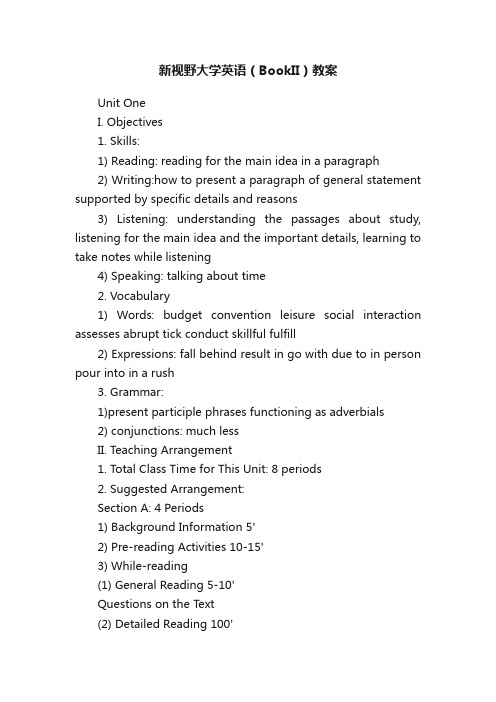
新视野大学英语(BookII)教案Unit OneI. Objectives1. Skills:1) Reading: reading for the main idea in a paragraph2) Writing:how to present a paragraph of general statement supported by specific details and reasons3) Listening: understanding the passages about study, listening for the main idea and the important details, learning to take notes while listening4) Speaking: talking about time2. Vocabulary1) Words: budget convention leisure social interaction assesses abrupt tick conduct skillful fulfill2) Expressions: fall behind result in go with due to in person pour into in a rush3. Grammar:1)present participle phrases functioning as adverbials2) conjunctions: much lessII. Teaching Arrangement1. Total Class Time for This Unit: 8 periods2. Suggested Arrangement:Section A: 4 Periods1) Background Information 5'2) Pre-reading Activities 10-15'3) While-reading(1) General Reading 5-10'Questions on the T ext(2) Detailed Reading 100'a. Words and Phrasesb. Language Pointsc. Sentence Patternsd. Main Idea of Each Part4) Post-reading(1) Useful Expressions 5'(2) Summary of the Text 10'(3) Structured Writing 15'(3) Exercises 45'(4) AssignmentsSection B: 2 Periods1) Reading Skills and Exercises 30'2) Detailed Study of the Text 50'3) Summary of the Text 20'14) Exercises 50'Listening and Speaking: 2 Periods1) Listening 75'2) Speaking 25'Section A Time-Conscious AmericansI. Background Information1. Time OrientationAmericans place considerable value on punctuality. Because they tend to organize their activities by means of schedules, they may seem harried, always running from one thing to the next and unable to relax and enjoy themselves. Since Americans are so time conscious, the pace of life may seem very hectic(紧张的). Being on time is regarded as very important, and in the U.S. most people make an effort to arrive on time. Not all Americans are punctual, but almost everyone is conscious of time. Differenttypes of activities have different conventions. One should arrive at the exact time specified for meals, and for appointments with professors, doctors, and other professionals. You can arrive any time between the hours specified for parties, receptions, and cocktail parties. Plan to arrive a few minutes before the specified time for public meetings, plays, concerts, movies, sports events, classes, church services, and weddings. If you are unable to keep an appointment, it is expected that you inform the other party that you will be late or unable to arrive.2. Hourglass:A glass container holding fine sand for measuring time, which is narrow in the middle like a figure8 so that the sand inside can run slowly from the top half to the bottom taking exactly one hour.沙漏:一种装上细沙以用来测量时间的玻璃容器,其颈部细小,形状象一个8字,使得上半部的沙子能缓慢地流到下半部中,其时间正好是一个小时。
新视野大学英语第二版第二册教案4(可编辑)
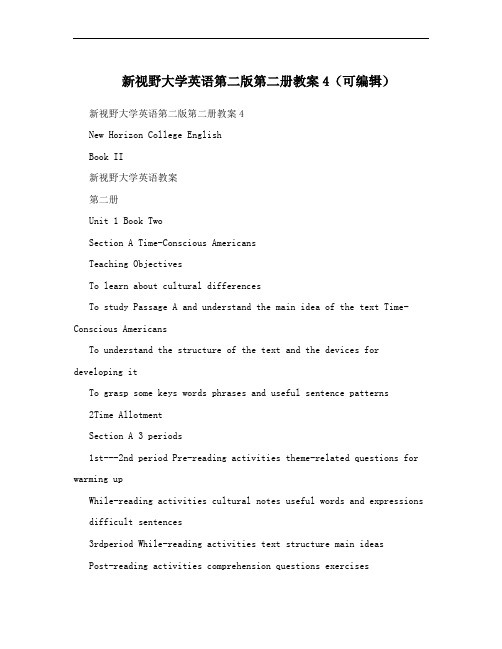
新视野大学英语第二版第二册教案4(可编辑)新视野大学英语第二版第二册教案4New Horizon College EnglishBook II新视野大学英语教案第二册Unit 1 Book TwoSection A Time-Conscious AmericansTeaching ObjectivesTo learn about cultural differencesTo study Passage A and understand the main idea of the text Time-Conscious AmericansTo understand the structure of the text and the devices for developing itTo grasp some keys words phrases and useful sentence patterns2Time AllotmentSection A 3 periods1st---2nd period Pre-reading activities theme-related questions for warming upWhile-reading activities cultural notes useful words and expressions difficult sentences3rdperiod While-reading activities text structure main ideasPost-reading activities comprehension questions exercisesSection B 1 period4th periods Practice of the reading skill reading for the main ideain a paragraphTeacher checks on Studens home reading by asking questions based on the passageTeacher explains some difficult sentences3Teaching Procedures31 Pre-reading ActivitiesStep 1 GreetingsGreet the whole class warmlyStep 2 Lead-in and preparation for readingShow some pictures and let them talk to each other about thefollowing questions1 How time is treated in China What is the difference with that in the USA2 What is culture shock3 How do Americans view timeStep 3 Fast readingAsk the Students to read the passage as quickly as they can and then answer the questions on the screen Let them get the main idea of each paragraph and make clear about the text structureText structure structured writing The passage can be divided into 3 partsPart I para1 Americans save time carefullyPart II paras 2-7 Americans attitude towards time and how they tryto save time in daily life and in businessPart III para 8 It is taken as a sign of skillfulness or being competent to solve a problem or fulfill a job successfully with speed in the USPurpose Improve the students reading and writing ability and understand the general idea of each paragraphMethod Read the text individually and talk in groups Use task-based language teaching method reading approach communicative approach and total physical response methodStep 4 Preparation for details of the text on the screenStudents are required to look at the Words and Phrases on the screen and give a brief presentation in classWords and PhrasesPurpose Train the Students ability of understanding and usingforeign languageMethod Talk in groups Use task-based language teaching methodcommunicative approach and total physical response methodbudgetto budget a new hospital 在预算中拨款建一家新医院a budget motel 一家收费公道的汽车旅馆replaceto replace the magazine on the shelf 把杂志放回到书架上Can anything replace a mothers love and care 有什么东西能取代母亲的关爱吗elbowHe elbowed me out of the way 他用肘把我推开了openingto apply for an opening申请一个空缺职位assessThey assessed the value of the house at 60000 他们估算这幢房子值6万美元savingIt took all our savings to buy the house 买这房子花去了我们的全部积蓄conductHe should learn how to conduct a meeting 他应该学会如何主持会议Copper conducts electricity well 铜具有良好的导电性能He was set free early because of good conduct 他因表现好而被提前释放fulfillto fulfill many duties in caring for the sick在护理病人时要履行许多职责I have fulfilled many of my youthful aims 我已实现了我年轻时的许多目标Does your job fulfill your hopes 你的工作符合你的期望吗32 While-reading ActivitiesStep 5 Intensive readingStudents are asked to read the passage carefully again and answer some detailed questions on the screen During the reading there is an explanation for the following pointsLanguage PointsAmericans believe no one stands still Para 1Meaning Americans believe no one keeps motionless everyone moves Here "stand" means "keep or stay in a particular position or state" In this sense "stand" is followed by adjectives More examples The room stands idle 这房间闲置着We are slaves to nothing but the clock Para 2Meaning We are under the control of time only and nothing else or we are only dominated by timeMany people have a rather acute sense of the shortness of each lifetime Para 2Meaning Many people have a very strong feeling that life is short Notice the use of "sense" in the following examplesa sense of humordutydirection 幽默感责任感方向感4 We want every minute to count Para 2Meaning We want every minute to be put into good use since it is preciousThey will miss the ritual interaction that goes with a welcoming cup of tea or coffeethat may be a convention in their own country Para 4Meaning They will be sad because they will not have the usual exchanges with the person who invited them that go with a welcoming cup of tea or coffee These exchanges may be a common practice on similar occasions in their own countrymuch less do they take them out for dinner or around on the golf course Para 4Meaning it is even less likely that Americans take their visitors out for dinner or to play golfmuch less 更不用说I can hardly walk much less run我几乎走不动更不用说跑了I didnt even see him much less speak to him我见也没有见到他更谈不上和他说话了Note that the phrase "much less" is often used after a negative statement to indicate that the statement is more true of the person thing or situation that you are going to mentionTime is therefore always ticking in our inner ear Para 4Meaning Therefore we are always aware of time It is just like the constant sound of a clock that we hearespecially given our traffic-filled streets Para 5Meaning especially when we take into account our busy streets that are often full of trafficThis is due partly to the fact that the telephone service is superb here whereas thepostal service is less efficient Para 7Meaning This is partly because of the fact that the telephoneservice is excellent here but by contrast the postal service is not so gooddue to 因为由于Her absence was due to the storm 由于风雨交加她没来Assignments are consequently given added weight by the passage of time Para 8Meaning As a result people think that assignments are gaining additional importance with the passing of timeThe word "weight" here is used as an uncountable noun metaphorically to mean "importance" More examplesan idea of great weight 一个很重要的观点Dont worry about what he thinks his opinion doesnt carry much weight 别担心他怎么想他的意见没有多少影响Usually the more important a task is the more capital energy and attention willbe poured into it in order to "get it moving" Para 8Meaning Usually if a job is more important people will put in more money effort and attention in order to get it doneStep 6 Typical patternsPurpose Further understand the text Train further reading ability to find out some difficult sentences and details of the textMethod Read the text together Use task-based language teaching method reading approach communicative approach grammar-translation approach and total physical response method1 as if 从句 as if 引导的方式状语从句一般用虚拟语气 egTime is treated as if it were something almost real2subject predicate object much less egPeople in the desert are always short of water to drink much less to bathe in沙漠地区的人们连喝的水也总是不够更别提洗澡了The baby cant even walk much less let alone run 宝宝连走路都不会更不用说跑了3It is considered adjto do sthSb Sth is taken as egIt is considered impolite to work too quickly It is taken as a sign of skillfulness or being competent to solve aproblem4 the 形容词比较级the 形容词比较级表示越?????? 越?????? egUsually the more important a task is the more capital energy and attention will be poured into it in order to get it moving 33 Post-reading ActivitiesStep7 ConsolidationRetell the passage according to the topic sentences Americans believe no one stands stillTime is treated as if it were something almost real A foreignersfirst impression of the USMany new arrivals in the StatesConsequently we work hard at the task of saving time Electronic communicationThe US is definitely a telephone countrySome new arrivals willPurpose To know if the students understand the whole text At the sametime To show the text structure on the screen so that they canretell it easilyMethod Read the text structure together Use task-based language teaching method reading approach communicative approach and total physical response methodStep 8 DiscussionShow a movie clip about the American life and ask the Students the following questionsPurpose To present a real situationTo grasp the main ideaTo consolidate language pointsTo fossilize the way of structured writingMethod Talk in groups Use task-based language teaching methodreading approach communicative approach audiolingual method Audio-visual method and total physical response methodStep 9 AssignmentsReview the key points of Section AFinish the exercises after classFinish online homeworkPreview Section BStep 10 AssessmentWrite a composition of a general statement supported by specific details and reasons I want to improve the ability of their writing At the same time train the ability of do-it-yourself and looking up the information by themselvesTeacher checks if Students have done the after-text exercises in their spare time and discuss some common errors that crop up Writing Topic Environmental protection has become a major concernfor societySpecific details teachers and students discuss environmental protectioncity planners take environmental problems into considerationfactories reduce pollutionReasons air and water pollution affects everyonecities to survivebusinesses to make a profitII Section B Culture ShockTeaching Procedures1 Reading SkillsReading for the Main Idea in a ParagraphThe main idea sentence is commonly known as a topic sentence or a topic statementThe topic sentence is usually puta at the very beginning of a paragraphb in the middle of a paragraphc at the end of a paragraphPurpose Introduce the reading skill to the Ss and improve their reading abilitiesMethod Use multimedia instruction and talk in groups Use task-based language teaching method reading approach communicative approach and total physical response methodTeacher explains the reading skill reading for the main idea in a paragraphStudents practise the skill by doing the exercise on page 1820 in pairs2 Passage Reading Culture Shock21 Lead-in and preparation for readingShow Students some pictures about foreign countries and let them talk to each other and then to look at the map of the world Purpose Arouse the students interest of study Bring in new subject Culture ShockMethod Talk in groups Use task-based language teaching method reading approach communicative approach audiolingual method and total physical response method22 Comprehension QuestionsRead the passage as quickly as they can and ask the Students to find the key idea of the passage and answer the questions on the screen Part I Para11 What do you think of studying in a foreign countryPart II Para2-72 What does honeymoon mean3 What do people do in the second stage of culture shock4 Say something about the defense mechanisms to protect people against the effects of culture shock5 What do people react in the third stage of culture shock6 What do people feel in the last stage of culture shockPart III Para 87 What are the benefits of experiencing culture shock23 Difficult Sentences1 Culture Shock means strong feelings of discomfort fear or anxiety which people may have when they enter another culture Usually when a person moves to live in a foreign country he may experience a period of culture shock until he becomes familiar with the new culture2 This is "the hostility stage" Para 3Meaning This is the stage in which you do not like many things in the new culture3 you devise some defense mechanisms to help you cope Para 4Meaning you create some methods to help yourself deal with things around successfully4This acquisition of understanding alleviates much of the stress Para 7Meaning This process of learning to understand helps you reduce a lot of your stress24 Key Words and Expressionsdesirable spite clash amuse isolate reject recognition recovery distinction appreciate alleviate come to go through1 desirableIt is desirable that interest rates should be reduceddesirable- undesirable2 spitein spite of –-despite regardless of3 clashThe leaders clashed with party members on the issue v disagree seriouslya clash of interests opinions cultures n4 amuseMy funny drawings amused the kids5 isolatePatients with the disease should be isolated vMany unemployed people experience feelings of isolation and depression6 rejectThe proposal was firmly rejected7 recognitionchange beyond out of all recognition 变得面目全非沧海桑田The town has changed beyond recognition since I was last here 8 recoveryThere is a reward for information leading to the recovery of the missing diamonds9 distinctionto make a distinction between arts and science 10 appreciateTheir investments have appreciated over the years 11 alleviateA number of measures were taken to alleviate the problem 12 come toThe doctors will operate if it proves necessarybut it may not come to that13 go throughHes amazingly cheerful considering all hes had to go through 3 AssignmentDo a quiz on the vocabularyTimed reading Fast Reading MaterialDo the exercises about vocabulary and phrases Students learnt inunit 1Teacher checks on Students exercises on pages 7 16Teacher checks on Students home reading 综合训练Teacher asks Students to prepare the next unitPurpose To know if students master the vocabulary and phrases inthis unitMethod Use task-based methodUnit 2 Book TwoI Section A Learning the Olympic Standard for Love1 Teaching ObjectivesTo know the meaning and usage of some important words phrases and patternsTo be familiar with the writing skills of the text and make use of it in writingTo improve Students reading skills by studying section BTo respond and cooperate with classmates willinglyTo participate activelyTo read sentences and texts with proper intonationTo write smoothly and legibly2Time AllotmentSection A 3 periods1st---2nd period Pre-reading activities theme-related questions for warming upWhile-reading activities cultural notes useful words andexpressionsdifficult sentences3rdperiod While-reading activities text structure main ideas Post-reading activities comprehension questions exercises Section B 1period4th periods Practice of the reading skill finding out word meanings Teacher checks on Students home reading by asking questions based on the passageTeacher explains some difficult sentences3Teaching Procedures31 Pre-reading ActivitiesStep 1 GreetingsGreet the whole class as usualStep 2 Review1 Ask students some questions to review Unit Oneshow them on the screen2 Check the homework1 Exercises2 Writing Assignment3 Preview of Unit TwoTopics1 Do you understand the meaning of commitment truly2 Which athlete do you admire most and whyPurposes1 To develop Students online learning ability2 To improve Students ability to retrieve the relevant information3 To stimulate Students psychomotor thinking4 To arouse Students interest in learning the unitMethod Talk in groups Use task-based language teaching method communicative approach and audiolingual methodStep 3 Lead-in and preparation for readingShow the Ss some pictures and let them talk to each other about the topic on the screenPurpose Arouse the students interest of study Bring in the subject of the textMethod Use the CAI PPT software and talk in groups Use task-based language teaching method communicative approach audio-visual method and audiolingual methodStep 4 Fast readingAsk the Students to read the passage as quickly as they can and to answer the questions on the screen Let them get the main idea of each paragraph and make clear about the text structureText structure structured writingPurpose Improve the students reading and writing ability and understand the general idea of each paragraphMethod Read the text individually and talk in groups Use task-based language teaching method reading approach communicative approach and total physical response methodStep 5 Preparation for details of the text on the screenStudents are required to look at the words and Phrases on the screen and give a brief presentation in classPurpose Train the Students ability of understanding and usingforeign languageMethod Talk in groups Use task-based language teaching method communicative approach and total physical response method Words and Phrases1(sessiona question-and-answer session before the final examination一堂考前答疑课tickets for the guitar session吉它演奏会的门票the next session of Parliament 议会下一的次会议2 lowerThe price will be lowered from 150 to 100 价格将从150 美元降到100 美元National flags were lowered to half-mast in memory of this great man 国旗下半旗以纪念这位伟人3 gratitudeI owe a debt of gratitude to you 我真得感谢你们 4 fussfuss too much about 过于关注make so much fuss over 对如此小题大做make a fuss about 为大惊小怪5 indifferentbe indifferent to prep 对毫不在意6 rebelrebel against反抗7 swearto swear at sb 咒骂某人to swear to fight for 宣誓为而战8 persistto persist in cause trouble to sb 不停地在给某人惹麻烦 The drought persisted for months and people prayed to Heaven for rain 干旱持续了几个月人们祈求天神降雨9 frownto frown at 不快地对皱起眉头10 rankOur success in research ranked as one of the greatest achievements in this field我们在研究上取得的成功被列为该领域最大的成就之一some high-ranking officials 一些高官All fruits were ranked neatly in the boxes 水果全都整整齐齐地排列在盒子里to hold the rank of 担任一职to marry a woman from a family of rank 娶一位名门之后11 next toI put these two pictures next to each other for comparison 我把两张照片放到一起来比较The mysterious villa stood silently next to a church 那栋神秘的别墅静立在教堂旁边12 in sbs presencein the presence of sb in the same place as sbYou should be a gentleman in the presence of ladies在女士们面前你应该表现得像个绅士13 by no meansI will by no means tell the secret to him without your permission不经你的许可我决不会把秘密告诉他He is by no means the richest person in this neighborhood 他决不是这个地区的首富14 count onYou cannot count on others for your own future 你自己的将来不能指望别人You can always count on him he is such a reliable person你总能依靠他他非常让人信赖15 come uponI came upon my favorite singer at the airport 我在机场偶然遇见了自己最喜欢的歌手We came upon a shabby wooden house in the middle of the wood我们偶然发现在树林中央有一所破旧的木屋16 pack intoto pack everything into the cupboard 把所有的东西都塞进小橱里17 take notice of noticeHave you taken notice of his strange behavior today你有没有注意到他今天奇怪的行为Father seemed to take little notice of my unhappiness and sat down for his supper父亲看来没注意到我的不快坐下来吃晚饭了18 sing outWe all sang out our wishes for the future at the top of the mountain 在山顶我们都大声说出了对未来的期望Joan sang out her plan believing that it was much better than others 琼相信她的计划比其他人的要好得多于是就大声说了出来32 While-reading ActivitiesStep 6 Intensive readingStudents are asked to read the passage carefully again and answer some detailed questions on the screen During the reading there is an explanation for the following pointsLanguage Points1(Nikolai Petrovich Anikin was not half as intimidating as I had imagined he would be Para1 Meaning I had expected that Nikolai Petrovich Anikin would be a quite frightening personbut actually he was not at all2 But Nikolai he was Petrovich and all Para2Meaning But anyway he was Nikolai Petrovich Anikin and nobody else3 I was a promising amateur skier but by no means the top skier in the country Para4 Meaning Though it seemed that I might be successful someday as an amateur skier I was notat all the best skier in the countryNotice that when "by no means" is used at the beginning of a sentence an inversion structureshould be used For exampleBy no means can teaching in school be separated from practice学校教学决不能脱离实践By no means will our friendship be affected 我们的友谊不会受到影响4 To be sure there were countless training sessions full of pain and more than a few tears Para 5Meaning I really went through a lot of painful training sessions which made me shed many tears5 I am practice practice practice in the stadium Para6 Meaning I practice all the time in the stadiumNote that Nikolai was not a native speaker of English he couldnt speak standard English So in the text we could see now and then he used bad grammar Here is just one example6 Romantic and otherwise Nikolai knew love Para 9Meaning No matter Nikolai was romantic or not he understood what love was7 Still he never babied me Para 10Meaning However he never spoiled me He was always very strict with me in training8 Once he packed 10 of us into a Finnish bachelors tiny home for a low-budget ski camp Para 12Meaning Once he arranged for 10 of us to stay in a Finnish bachelors small home for a low-cost ski camp9 We awoke the first morning to find Nikolai making breakfast and then made quick work with our spoons while sitting on makeshift chairs around a tiny card table Para12Meaning The first morning we woke up and found Nikolai making breakfast We had our breakfast quickly with spoons while sitting on something we could use as chairs around a very small card table10 When we were finished Nikolai stacked the sticky bowls in front of my sole female teammate and me asserting "Now girls do dishes" Para 12Meaning When breakfast was over Nikolai piled up the oily dirty bowls in front of the only other female on the team and me and said forcefully "Now girls wash the dishes"11 "Ask the damn boys This is unfair" Para13Meaning "I dont think its right to ask only the girls to wash the dishes I believe boys should do it as well"The word "damn" is used to show that you are angry or annoyed with someone or something For exampleI cant get this damn button undone 我解不开这个该死的扣子12 When coaching he would sing out his instructions keeping rhythm with our stride Para 14Meaning While training us he would give his instructions in a loud and clear voice keeping rhythm with our movement13 "Billion times you make motion―then be perfect" reminding me in an Ive-told-you-a-billion-times tone "You must be patient" Para18 Meaning "You must be patient and make the movement ie bring your knee down faster many times before itll be perfect" His tone suggested that he was annoyed for he had told me this many times in the pastTypically if we talk about a billion of or billions of people or things we mean that there is a very large number of them but you do not know or do not want to say exactly how manyAlso note that here "Ive-told-you-a-billion-times" is a compound adjective formed from an attributive clause More examplesa never-to-be-forgotten film 一部永远不会忘记的电影a not-so-strong football team 一支不太强大的足球队14 but then I missed the cut for the 2002 Olympics Para19"Miss cut" is originally a term in golf which means that a player fails to hit the golf ball into a hole In the sentence "miss the cut" means the writer failed to be selected to take part in the 2002 Olympic Games15 He taught me to be thankful in advance for a century of life on earth and to remind myself every day that despite the challenges at hand "Now must be love love love" Para 21Meaning He taught me to be thankful for the life I will live in this world and to remind myself every day that though I were facing all kinds of challenges I must love wellPurpose Further understand the text Train further reading ability to find out some difficult sentences and details of the text Method Read the text together Use task-based language teaching methodreading approach communicative approach grammar-translation approach and total physical response method33 Post-reading ActivitiesStep7 ConsolidationRetell the passage according to the following questionsHow did the writer feel when she met Nikolai for the first time As a self-confident amateur skier the writer was already thinking of participating in the Olympics before she met Nikolai wasnt she How would you describe the training sessions after Nikolai began to coach the writerDid Nikolai himself try very hard at skiing when ha was youngHow would you describe the relationship between the writer and her coachWhen did a lady friend of the writers grandfather once ask whether Nikolai also taught danceWhat did they achieve through hard training Did they participate in the Olympics as they had expectedWhat did the writer learn from NikolaiPurpose To know if the students understand the whole text At the same time To show the text structure on the screen so that they can retell it easilyMethod Read the text structure together Use task-based language teaching method reading approach communicative approach and total physical response methodText StructurePart I Para 14 Introduction to Nikolai and his high expectationsPart II Prar 519 The Olympic standard of love as shown by Nikolai Part III Para 20 A transitionPart IV Para 21 Conclusion What Nikolai taught the writerStep 8 DiscussionShow a movie clip about the life and matches of some famous Olympic athlets and ask the Students to talk about themPurpose To present a real situationTo grasp the main ideaTo consolidate language pointsTo fossilize the way of structured writingMethod Use the CAI and talk in groups Use task-based language teaching methodreading approach communicative approach audiolingual methodAudio-visual Method and total physical response methodStep 9 AssignmentReview the key points of Section AFinish the exercises after classFinish online homeworkPreview Section BStep 10 AssessmentWrite a composition of a general statement supported by details I want to improve the ability of their writing At the same time train the ability of do-it-yourself and looking up the information by themselvesTeacher checks if Students have done the after-text exercises in their spare time and discuss some common errors that crop up Writing Topic Computer problemsGeneral Statement Computers have a negative sideDetails 1 computer-controled machines making many people lose their jobs2 computer crimes3 health problemsII Section B The Standard for Olympic ExcellenceTeaching Procedures1 Reading SkillsFinding Out Word MeaningsIn order to find out word meanings we have to look for context clues such as definition examples synonyms antonyms word stems and suffixes and our comon sensePurpose Introduce the reading skill to the Students and improvetheir reading abilitiesMethod Use multimedia instruction and talk in groups Use task-based language teaching method reading approach communicative approach and total physical response methodTeacher explains the reading skill finding out word meaningsStudents practise the skill by doing the exercise on page 41 in pairs2 Passage Reading The Standard for Olympic Excellence。
大学新视野英语第二册(第三版)课程教案

New Horizon College EnglishBOOK 2(3rd Edition)Unit 1 An Impressive English Lesson课型:□理论课√理论、实践课□实践课课时分配:6教学环境:多媒体教室教学目标:After studying this unit, the students are expected to be able to:1. understand the main idea and structure of Section A and Section B;2. master the key language points and grammatical structures in the texts3. talk about language teaching and learning and express their opinions about current way of teaching in an English class;4. read with the skill ―finding key ideas in sentences;5. write a composition with three main parts: introduction, body and conclusion.Key Issues:1. VocabularyTedious, absorbed, allergic, capture, condense, exceed, distinguish, distinctive, complimentary, complementary, proclaim, evidently, adequate, competent, adjust, beneficial2. SkillsLearn to read with the skill ―finding key ideas in sentences and write a composition with three main parts: introduction, body and conclusion.Potential Problems and Difficulties●To talk about language teaching and learning●write a composition with three main parts: introduction, body andconclusion.●To apply the phrases and patternsMethodology:A combination of traditional teaching methods with the communicative approach will be adopted. Special attention should be paid to classroom interaction like questioning and answers. Small group works are always needed while discussing the questions and the difficult translation practice. More encouragement is needed and more guidance will be given in their extracurricular study.Teaching Aids: Visual aids, projector, stereo and microphoneGroup work and pair workConduct of Tasks and Activities(师生互动方式Mode of Interaction; 学习策略Learning Strategies)Students-centered, Task-based teaching and learningTeaching ProceduresStep 1 Lead-inI. Greeting and warming-up questions discussion.1. What are the key factors that help people learn English as a foreign language?2. Do you have any problem in English learning?3. Do you think grammar is important in English learning?II. Listening and discussing.1. Listening practice.2. In your opinion, what is the most effective way to learn English?III. Listening to a talk and answer questions on page 2Step 2 Section A An Impressive English LessonI. Cultural background American university education1.What is Communicative Language Teaching?A type of teaching method;Develop the communicative ability as well as the knowledge of grammar;Learning by doing;Make classroom situation of real foreign language environment.2. What are the features of Communicative Language Teaching? Communicative competence is the goal;An integration of grammatical and functional teaching;Accuracy is secondary to conveying a message;Focus on communicative and contextual factors in language use; Learner-centered and experience-based.3. What is the role of teacher in Communicative Language Teaching?A facilitator of students’learning;A manager of classroom activities;An advisor of students’questions;A co-communicator in the communicative activity.II. Language PointsWords and expressions1. oddity: n. [C] a strange or unusual person or thing 怪人;怪物;奇特的东西With his neat suits on, he felt like an oddity walking in this poor neighborhood. 穿着笔挺的西装走在这个贫民区里,他觉得自己就像个怪物。
新视野大学英语二教案

教学目标:1. 学生能够理解并运用教材中的词汇和语法知识。
2. 学生能够阅读并分析文章,提高阅读理解能力。
3. 学生能够通过课堂讨论,培养英语口语表达能力。
4. 学生能够根据文章内容,撰写短文,提高写作能力。
教学内容:1. 单元主题:家庭与朋友2. 教材内容:Unit 1-4教学过程:一、导入(Lead-in)1. 利用图片、视频等资料,引导学生讨论家庭与朋友的重要性。
2. 提问:你最喜欢的家庭成员是谁?为什么?3. 引出本单元主题:家庭与朋友。
二、课文讲解(Text Explanation)1. 单元1:Family- 讲解课文中的词汇和语法知识。
- 分析课文结构,理解文章内容。
- 通过讨论,了解不同文化背景下家庭观念的差异。
2. 单元2:Friends- 讲解课文中的词汇和语法知识。
- 分析课文结构,理解文章内容。
- 通过讨论,了解不同文化背景下友谊观念的差异。
3. 单元3:Love- 讲解课文中的词汇和语法知识。
- 分析课文结构,理解文章内容。
- 通过讨论,了解不同文化背景下爱情观念的差异。
4. 单元4:The Importance of Communication- 讲解课文中的词汇和语法知识。
- 分析课文结构,理解文章内容。
- 通过讨论,了解沟通在家庭与朋友关系中的重要性。
三、课堂活动(Class Activities)1. 词汇游戏:通过游戏,帮助学生巩固词汇。
2. 阅读理解:让学生完成阅读理解练习,提高阅读能力。
3. 口语表达:组织学生进行小组讨论,提高口语表达能力。
4. 写作训练:让学生根据课文内容,撰写短文,提高写作能力。
四、课堂小结(Conclusion)1. 回顾本节课所学内容,总结家庭与朋友的重要性。
2. 鼓励学生在生活中关注家庭与朋友关系,学会沟通与理解。
教学评价:1. 课堂参与度:观察学生在课堂上的发言情况,评价其口语表达能力。
2. 阅读理解:通过阅读理解练习,评价学生的阅读能力。
新视野大学英语听说教程第2册教学设计

新视野大学英语听说教程第2册教学设计1. 简介《新视野大学英语》是一套由外研社出版的大学英语教材系列,分为四个级别:入门、基础、提高和达标。
本文旨在介绍《新视野大学英语》听说教程第2册的教学设计。
2. 教学目标本教材旨在帮助学生提高听力和口语技能,使其能够自信地与外国人对话,达到与英语母语人士交流的水平。
教学目标如下:•听力:能听懂日常用语和简短的对话,听懂英语演讲和电影中的简单对话。
•口语:能进行社交交往,能够描述个人经历、兴趣爱好和旅行经历。
3. 教学内容本教材共包含14个单元,每个单元包括听力和口语部分。
整个教学过程涵盖了以下主题:1.个人经历2.社交礼仪3.意见交流4.家庭和朋友5.旅游和文化6.祝贺和感谢7.过去和未来8.身体和健康9.职业和工作10.文化差异11.大学生活和课外活动12.环境和可持续发展13.城市生活和交通14.烹饪和饮食文化4. 教学方法本教材的教学方法主要包括听力练习、口语练习、角色扮演和小组讨论。
具体实施方式如下:4.1 听力练习教师将音频材料播放给学生听,同时提供听力题,帮助学生提高听力理解和积累语言知识。
教师应该提醒学生,听力练习需要多次反复,掌握每个单元的语音、语调和语速是非常重要的。
4.2 口语练习教师可以在课堂上让学生进行口语练习,以便更好地理解听力材料,并能够流利地进行英语交流。
教师可以提供话题和问题,让学生自由表达观点和想法。
此外,教师还可以赋予学生角色,例如在一个场景中扮演旅游助理和游客,以此锻炼学生的英语应用能力。
4.3 角色扮演角色扮演是一种有效的练习口语的方法。
在角色扮演中,学生需要扮演一个特定的角色,在模拟的情境中进行英语交流。
这种方法能够帮助学生提高英语应用能力,理解语言交流中的背景和上下文。
4.4 小组讨论小组讨论是一种非常有效的交流和合作学习的方式。
在这种活动中,学生被分成小组,讨论特定的话题。
教师可以将活动限制时间,以帮助学生更好地沟通和组织语言。
新版新视野大学英语2教案
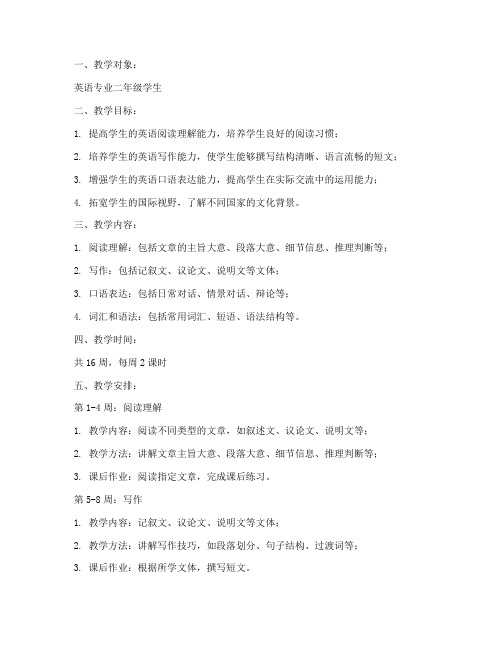
一、教学对象:英语专业二年级学生二、教学目标:1. 提高学生的英语阅读理解能力,培养学生良好的阅读习惯;2. 培养学生的英语写作能力,使学生能够撰写结构清晰、语言流畅的短文;3. 增强学生的英语口语表达能力,提高学生在实际交流中的运用能力;4. 拓宽学生的国际视野,了解不同国家的文化背景。
三、教学内容:1. 阅读理解:包括文章的主旨大意、段落大意、细节信息、推理判断等;2. 写作:包括记叙文、议论文、说明文等文体;3. 口语表达:包括日常对话、情景对话、辩论等;4. 词汇和语法:包括常用词汇、短语、语法结构等。
四、教学时间:共16周,每周2课时五、教学安排:第1-4周:阅读理解1. 教学内容:阅读不同类型的文章,如叙述文、议论文、说明文等;2. 教学方法:讲解文章主旨大意、段落大意、细节信息、推理判断等;3. 课后作业:阅读指定文章,完成课后练习。
第5-8周:写作1. 教学内容:记叙文、议论文、说明文等文体;2. 教学方法:讲解写作技巧,如段落划分、句子结构、过渡词等;3. 课后作业:根据所学文体,撰写短文。
第9-12周:口语表达1. 教学内容:日常对话、情景对话、辩论等;2. 教学方法:组织课堂讨论、角色扮演、辩论等;3. 课后作业:进行口语练习,提高实际交流能力。
第13-16周:词汇和语法1. 教学内容:常用词汇、短语、语法结构等;2. 教学方法:讲解词汇用法、短语搭配、语法规则等;3. 课后作业:积累词汇,掌握语法结构。
六、教学评价:1. 课堂表现:积极参与课堂活动,回答问题准确;2. 课后作业:按时完成作业,质量较高;3. 期中、期末考试:检测学生的综合能力。
七、教学资源:1. 教材:《新视野大学英语2》;2. 教学课件:PPT、Word等;3. 网络资源:英语学习网站、视频等。
八、教学反思:1. 教师应根据学生的实际情况,调整教学内容和教学方法;2. 注重培养学生的自主学习能力,鼓励学生积极参与课堂活动;3. 及时关注学生的学习进度,发现问题并及时解决。
- 1、下载文档前请自行甄别文档内容的完整性,平台不提供额外的编辑、内容补充、找答案等附加服务。
- 2、"仅部分预览"的文档,不可在线预览部分如存在完整性等问题,可反馈申请退款(可完整预览的文档不适用该条件!)。
- 3、如文档侵犯您的权益,请联系客服反馈,我们会尽快为您处理(人工客服工作时间:9:00-18:30)。
全新版《大学英语》教案课程名称:大学英语(二级)专业:建筑城规、土木、自动化、光电、电气和数理等学院年级: 2007级学年: 2007-2008学期:第二学期任课教师:全新版《大学英语》板块任课教师编写时间:2008年1月Course ScheduleAims:1)在上学期学习的基础上,根据学生的学习情况和考试情况,帮助学生找出薄弱环节,有意识地查缺补漏,继续复习巩固语法知识,扩大学生词汇量。
加强词汇的记忆,听写以及同义词,拼写相似的词语,容易混淆的词语的对比学习和实际运用,增强学生记忆和运用词汇的能力。
2)加强阅读及阅读单项技能的训练。
一是完成第二册所有阅读教程的单项阅读技能的训练,二是复习巩固第一册所学过的单项阅读技能及其综合运用。
并认真督促学生完成泛读任务,扩大阅读量。
同时要在课堂上进行快速阅读训练。
3)加强汉英及英汉翻译练习。
督促学生完成综合教程每课后的段落翻译。
翻译练习有助于学生写作能力的提高。
4)重视写作能力的培养和写作方法的训练。
让学生具有初步的记叙文、说明文和议论文的写作概念和经验。
5)督促学生认真做好课外听音,保证每天有半小时至一小时的听力训练。
Required course materials:College English (New Edition Book 2)—Integrated Curse, Listening and SpeakingCourse, Reading CourseNote: The Reading Course Book is used as Ss’ self-access learning material.Useful English Learning Resources: Magazines: English Language Learning, College English, English Salon, English Weekly, The world of English, English Digest, Overseas EnglishNewspaper: 21st Century, China Daily Websites: (英语比萨园地); (听力快车); (普特英语听力); (英文写作网); (旺旺英语); (中国日报); (英国卫报) (华盛顿邮报)新版《大学英语》二级教学日历(2008.2-2008.6)Notes:1.The teacher logs onto the Management Platformof the Interactive English Learning Systems regularly to check students self-access learning.2.Activities for the speaking classes arerelated to students’ self-access learning.Supporting materials and upcoming classroom activities are assigned to students one week ahead of time so that they will have enough time to prepare for the tasks.Unit 1 Ways of Learning1. 教学目标及基本要求:Students will be able to:1)grasp the main idea (that it would be ideal ifwe can strike a balance between the Chinese and the Western learning styles) and structure of the text (introduction of the topic by an anecdote; elaboration by comparison and contrast; conclusion by a suggestion);2)appreciate the difference between comparisonand contrast, as well as different ways to compare and contrast (point-by-point or one-side-at-a-time method)3)master key language points and grammaticalstructures in the text;4)conduct a series of reading, listening,speaking and writing activities related to the theme of the unit.2. 教学内容及学时分配:Time allotment:1st period: pre-reading; Text Organization; While-reading (Part One)2nd period: While-reading3rd period: Text Analysis; Post-Reading Tasks4th period: Reading Practice5th period: Speaking6th period: Writing3. 教学重点及难点:Important language points and sentence structures in the text:4. 教学内容的深化及拓宽:Students conduct a series of reading, listening, speaking and writing practice to deepen their understanding of the points taught in class.5. 教学方式及在教学中应注意的问题:A combination of traditional teaching methodswith the communicative approach will be adopted. Special attention should be paid to classroom interaction. Give students more encouragement and guidance in their extracurricular study.6. 主要参考书目:季佩英,吴晓真,姚燕瑾,2002,《全新版大学英语综合教程2-教师用书》。
上海:上海外语教育出版社。
董欣,宋海波,柯彦玢,2002,《全新版大学英语阅读教程2-教师用书》。
上海:上海外语教育出版社。
7. 思考题和习题:《全新版大学英语综合教程2》第一单元Text A后的所有习题。
阅读第一单元Text B,完成后面的相关练习。
《全新版大学英语阅读教程2》第一单元及相关练习。
《大学英语阅读进阶2》第一单元及相关练习Writing Assignment1st Period1.Pre-Reading Discussion (8 minutes)There is much difference between learning in China and that in America. Discuss the difference with your partner. Write the main points on a piece of paper!2. Read the following statements about different family education patterns and discuss with your partner whether you agree or disagree to those ideas and why. (10 minutes)1) The child's acquisition(学会) of each skill in their growth should be guided or directed by his/her parents.2). In the process of children's learning new skills, parents should achieve a balance between pushing them too hard and leaving them on their own.3). Parents should realize that " example is better than precept(说教)."4). Parents should not be especially strict inmoney matters in the growth of their children.5). The pouring of all the love to their children will make them become very spoiled and self-centered.3. A Brief Introduction of two different learning modes. (5 minutes)Much of the current debate over education surrounds the extent to which learning should be teacher-based or student-based. Which of the two should decide what should be learned, how it should be learned, and when it should be learned. Comparing Western and Asian methods of learning it is generally true that Western methods are more student-centered, expecting students to discover things for themselves rather than relying on their teachers to tell them.4.Text Organization (10 minutes)Students are required to do the text organization exercise in the textbook.5. Detailed Reading of Part I (Paragraphs 1 - 5) (12 minutes)1) Skim paragraphs 1--5 and be ready to answer the following questions:Where and when did the incident take place?Who are the main characters in this incident?What is the attitude of the author and his wife toward Benjamin's efforts in inserting the key into the slot?What is the attitude of the hotel staff toward Benjamin's efforts?Language Points covered in this part: (Detailed Explanation is to be found in the courseware) Attach; not…in the least; find one’s way into; initial; on occasion; neglect; relevant;2nd Period1. Detailed Reading of Part II (Paragraphs6-13)1) Scanning (8 minutes)Students skim this part and then answer the following questions:What did the Chinese colleagues think of the key-slot incident?What did the author emphasize in presenting his views about the incident?2) Detailed Reading (25 minutes)The teacher explains this part of the text, important language points and grammatical structures to the students.Language points covered in this part: Exception; accomplish; in due course; critical; principal & principle; make up; facility; performance; continual and continuous; apply to, apply for, appliance, priority, evolve, summarize , contrast, promote, emerge2. Detailed Reading of Part III1) Scanning (5 minutes)Students are required to skim Part III of the text and then answer the following question: What suggestion does the author make about seeking a better approach to foster skills and creativity?2) Detailed Reading (7 minutes)The teacher explains the text, language points and difficult grammatical structures in this part:Language points covered in this part: assuming, superior, inferior3rd Period1.Text Analysis1) Ways of introducing a topic (15 minutes)H o w t o i n t r o d u c e a t h e m e?To state topic directlyTo introduce an anecdote or an incidentTo pose a questionTo quote newspaper headlinesTo make an analogy(类比)To give a definitionTo pose an imagined argumentStudents are required to identify how the author introduces the theme in Text A.Hint: In this text, an anecdote or an incident is used.Practice:Students read the following sentences and discuss how the authors introduce the themes. Read the following statements to decide which way is used to introduce the essay.“Devastation by El Nino– a Warning. This piece of news has aroused the attention of many people”--to quote newspaper headlinesDo animals all have thoughts, what we call consciousness?”--to pose a questionParents who decide that the time has come to teach their children about money usually begin by opening savings accounts. --to pose an imagined argumentA traditional story describes a foolish manlifting a rock too heavy for him and having his own feet squashed. Hitler was like that foolish man, but he was different in that,….---to make an analogyFascism can be defined as the use of brutal force in enslaving the people at home and the people of foreign countries…---to give a definitionToday, I would like to focus on the hot issue of green house effect in the world…--to state the topic directly2) Comparison and contrast (15 minutes)Scan the first sentence of Both Para 6 and Para 7. and then decide what kind of comparison and contrast is used here?Sum up the contrast between Chinese and Western ways to learn to accomplish a task..2. Translation: (15 minutes)Students translate text-related words and expressions from Chinese to English. (See the CD-Rom)4th PeriodThe teacher explains the main idea of the 3 passages in the reading course and introduce relevant reading strategies to the students.1. Passage One: (15 minutes)1) The teacher explains the main idea of the text.2) Reading strategies:Diction:Students study the following sentences from the text and decide its diction level...and we want to say a few things that might not get said in casual conversation: thank you for what you've meant to me, I am very happy right now. (L.29)Few letters are obligatory, and they are Thanks for the wonderful gift and I am terribly sorry to hear about George's death and Yes, you're welcome to stay with us next month,and not many more than that. Write those promptly if you want to keep your friends. (L.37)…so keep your writing stuff in one place where you can sit down for a few minutes and Dear Roy,I am in the middle of an essay forInternational Paper but I'd drop you a line.Hi to your sweetie too, dash off a note to a pal. (L.46)Audience:Audience here refers to the potential readers ofyour writing. Your audience may influence your choice of topic, tone, and diction. The following questions will help your students identify the audience of the text.2. Passage Two (15 minutes)1) The teacher explains the main idea of the text to the students.2) Reading strategy:Division---ClassificationWhen using the pattern of division, you break a subject into its elements and examine the relations between them. Classification involves separating a large group into smaller groups based on the characteristics of the individual items.Students read the following short paragraph and answer the questions that follow.Energy sources can be divided into two types: those which are renewable, and those which arenot renewable. Energy sources which are not renewable mainly come from fossil fuels such as oil, coal, and natural gas. Because these sources are limited in supply, human beings must exploit alternative energy sources lest one day they should be used up. Renewable energy sources include tidal wave; wind energy; geothermal energy; energy from biomass; solar energy; photovoltaics; and other unconventional and alternative energy sources. Although the cost for some of the new sources may be substantial, they are cleaner to use than fossil fuels and will become popular in the future.Energy sources in the world can be roughly divided into two kinds. What are they?These two kinds of energy sources can be further classified into several categories.What are they?3. Passage Three (15 minutes)1) The teacher explains the main idea to the students.2) Reading Strategy:Implications: Reading Between the Lines Students read the following short passage and then do the exercises that follow.I have taught in high school for ten years. In that time I have given assignments to many students, including a murderer, an evangelist(传教士), a boxer, a thief, and an imbecile(低能儿). The murderer was a quite, little boy who sat on the front seat and look at me with pale blue eyes. The evangelist, easily the most popular boy in the school, had the lead in the junior play. The boxer lounged (懒洋洋地靠)by the window and let loose at intervals with a raucous (粗声的)laugh that surprised even the flowers. The thief was a gay-hearted soul with a song on his lips. And the imbecilewas soft-eyed little fellow who preferred to remain unnoticed.All of these boys, I taught them the rhyming schemes (韵律)of the Elizabethan sonnet (十四行诗)and how to diagram a complex sentence.a. Students underline the sentence which suggests that the narrator is an experienced teacher.b. This passage suggests thata) Adult personality can be predictedb) School grades influence the future.c) Schools ignore individual needs.d) People are unpredictable.c. Apparently the narrator feelsa) Self-satisfied.b) Threatened.c) Discouraged.d) Hatefuld. The narrator seems to be making a plea (恳求) fora) More meaningful educationb) Revision of English coursesc) Better classroom disciplined) Guidance in the elementary grades.5th Period SpeakingSpeaking (1): Good Language Learners & Language Learning Strategies1. Task One: SILL is a questionnaire designed specifically to check the strategies that students use in their English learning process. It can also help students to find out what strategies they use less frequently than others, thus helping them detect their weaknesses. They may use the result as guidance for changes that they may make in the future in order to improve their English learning.Students finish the SILL questionnaire individually. (20 minutes)2. Task Two: (15 minutes)Students are required to work in small groups and think of at least five characteristics of a good language learner.3. The teacher explains characteristics of good language learners to students. (10 minutes)6th Period WritingWriting (1) Comparison and Contrast1.Students discuss the questions on page 28 oftheir textbook in small groups. Group reporters share their ideas with the whole class at the end of their discussion. (15 minutes)2.Students read the Writing Strategy on page 29of their textbook. The teacher explains important points about essays of comparison and contrast to the students. (10 minutes)3.Students draft their essay following theinstructions in their textbook. (20 minutes)Each of the students is required to have his /her essay corrected by a classmate before he /she hands it in next week.Unit 2 The Richest Man in America, Down Home1. 教学目标及基本要求:Students will be able to:1)Understand the main idea (despite his wealth,Sam Walton remains down-home and devoted to his team ) and the structure of the text.2)Appreciate the use of indirect description inportraying a person;3)Grasp the key language points and grammaticalstructures in the text.4)Conduct a series of reading, listening,speaking and writing activities related to the theme of the unit.2. 教学内容及学时分配:Time allotment:1st period: pre-reading; Text Organization; While Reading (Paragraph 1-4)2nd period: While-reading3rd period: Text Analysis; Post-Reading Tasks4th period: Reading Practice5th period: Speaking6th periods: Writing3. 教学重点及难点:Important language points and sentence structures in the text:4. 教学内容的深化及拓宽:Students conduct a series of reading, listening, speaking and writing practice to deepen their understanding of the points taught in class.5. 教学方式及在教学中应注意的问题:A combination of traditional teaching methods with the communicative approach will be adopted. Special attention should be paid to classroom interaction. Give students more encouragement and guidance in their extracurricular study.6. 主要参考书目:季佩英,吴晓真,姚燕瑾,2002,《全新版大学英语综合教程2-教师用书》。
